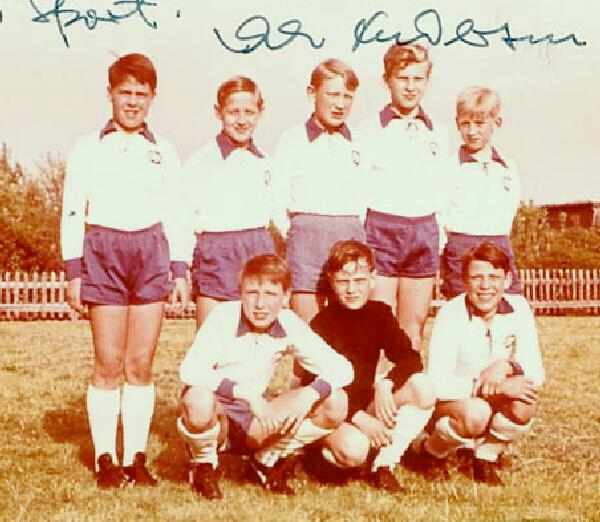
German Soccer Uniforms: Chronology

Figure 1.--Here we see a German soccer club team in 1965-66. It is enscribed, "Gut Sport. Lale Andersen" at the top. Below the photograph is enscribed, "Blauweiss - DJK - Schinkrl. I. Knaben - Stadtmeister 1965-66. Autogramm der Sängerin 'Lale Andersen' auf der Fahrt nach 'Langeoog'".
Blau Weiss DJK Schinkel is a large sporting club in Osnabrück, Germany. " I. Knaben - Stadtmeister 1965-1966" means that their 1st Boys' Division won the Municipal Competition for 1965-1966." The team portrait was autographed by the singer Lale Anderson on the trip to Langeoog. Lale Andersen (Lieselotte Helene Berta Bunnenberg, 1905-72) was the famous cabaret performer and singer who first recorded "Lili Marlene" in 1938, or was it 1939?, and scored another big hit after the War in the 1960s with the German version of Hadjidakis' song "Ta pidea to Pirea" ("Never on Sunday" was the English version). Langeoog is one of the East-Friesian islands off the German
North Sea coast.
|
|
We know very little about German soccer uniforms in the early 20th century. German soccer teams were real power houses in the 1950s and 60s. This helped to create great enthudiam for the sport among boys. There is even a movie addressing this topic. Wehave noted German boys participating in soccer leagues with uniformed teams in the 1960s. I assume this probavly began in the 1950s, but we do not yet have any images from the 1950s confirming this. We do note photographs of German boys playing soccer in the 1950s, but they are not wearing team uniforms. We also notice other sports clubs from the 1960s. A British reader who traveled to Germany as a boy remembers the Germans boys swim club having quite elaborate uniforms. Soccer uniforms varied. We note some jerseys were done in the rugby style, but not in stripes. Many boys had kneesocks with stripes at the top. The shorts were commonly one color and cut hort. This can be seen in the socks boys are wearing in many photographs. Uniforms were still generally plain in the 1960s. Here we see a typical uniform from the 1960s. Notice the collared shirts in the rugby style. The boys wear plain white shirts with blue collars and blue shorts. Generally over time the uniforms got flashier. The shorts became much longer in the 1990s. A German reader writes in 2006 when Germany hosted the World Cup, "Soccer is sooooooooooooo popular in Europe. As the World Cup is in Germany this time everything you can see here in shops or whatever is related to soccer. You just can buy everything decocareted with footballs or in football shape. Just some examples: toilet paper, clothing, food, games, ... Just crazy!"
HBC

Navigate the Boys' Historical Clothing Web Site casual pages:
[Return to the Main German soccer uniform page]
[Return to the Main German sports page]
[Camp shorts]
[Clam diggers]
[Cord shorts]
[Jeans]
[Jump suits]
[Koveralls]
[Lederhosen]
[Pinafore]
[Shortalls]
[Smocks]
Navigate the Boys' Historical Clothing Web Site:
[Return to theMain short pants page]
[Introduction]
[Activities]
[Biographies]
[Chronology]
[Clothing styles]
[Countries]
[Essays]
[Bibliographies]
[Contributions]
[FAQs]
[Glossaries]
[Satellite sites]
[Tools]
[Boys' Clothing Home]
Created: 9:36 PM 7/28/2004
Last updated: 11:02 PM 6/9/2006



